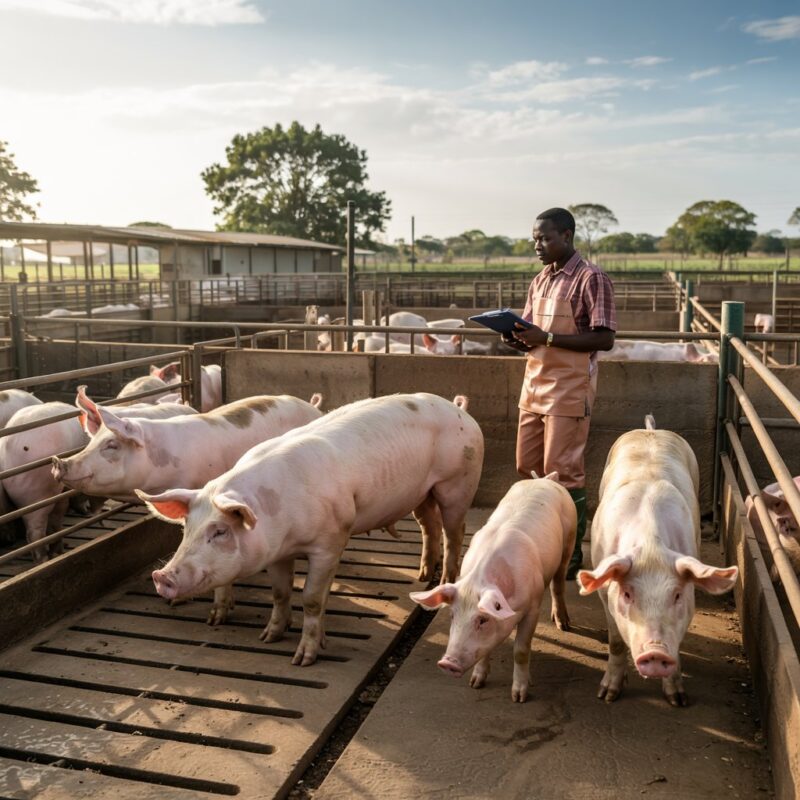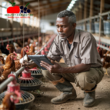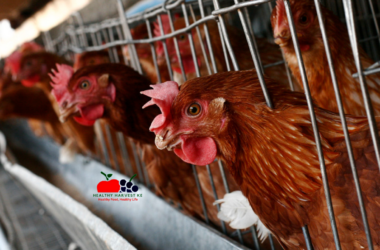Feeding pigs in Kenya doesn’t have to break the bank. Whether you’re raising a few animals in your backyard or scaling up your operation, understanding how to formulate cost-effective diets using locally available ingredients can make all the difference between profit and loss.
The Real Challenge for Kenyan Pig Farmers
If you’re raising pigs in Kenya, you already know the struggle. Commercial feeds are getting crazy expensive—with a 50kg bag of sow and weaner feed hitting around Sh1,950 and lasting barely two weeks. That’s enough to make any smallholder farmer question if it’s even worth it.
But here’s the good news: local pigs actually have different nutritional requirements than those fancy exotic breeds. Research shows they can thrive on locally available feedstuffs when properly balanced. Your indigenous pigs need about 2960 kcal/kg of digestible energy and 85g/kg of crude protein—notably lower than commercial breed requirements.
Understanding Pig Nutritional Needs by Growth Stage
Starter Pigs (Weaners: 8-35kg)
Young pigs are like teenagers—they’re growing fast and need the right fuel. For local pigs weighing between 8-35kg, your focus should be on providing:
- Digestible energy: 2960 kcal/kg dry matter
- Crude protein: 85g/kg dry matter
- SID lysine: 5.8g/kg dry matter
- Calcium: 2.8g/kg dry matter
- STTD phosphorous: 1.4g/kg dry matter
These requirements might seem technical, but they translate to selecting the right mix of local feeds. Young pigs need more protein and energy proportionally than adults, so this is where strategic use of protein sources like dried fish (omena) makes a huge difference.
Growing Pigs (35-60kg)
As pigs move into the growing phase, their rate of muscle development starts changing. Studies in Western Kenya show pigs aged 5.1-9.9 months achieve the highest average daily gain of around 127g—significantly better than younger or older pigs.
For this growth stage, focus on:
- Balanced energy-to-protein ratio
- Consistent feeding schedule (2-3 times daily)
- Gradual introduction of more fibrous ingredients
- Maintaining adequate water supply separate from feed
Finishing Pigs (60kg to market weight)
At this stage, your pigs are putting on the final pounds before market. This is where feed efficiency becomes crucial to your bottom line. Research evaluating semi-intensive pig rearing in Western Kenya found that variations in average daily gain resulted in feed cost differences of up to 982 KES for growing a pig to market weight.
For finishing pigs, consider:
- Slightly reduced protein levels
- Increased energy density
- More agricultural byproducts to reduce costs
- Strategic use of any commercial feed supplements
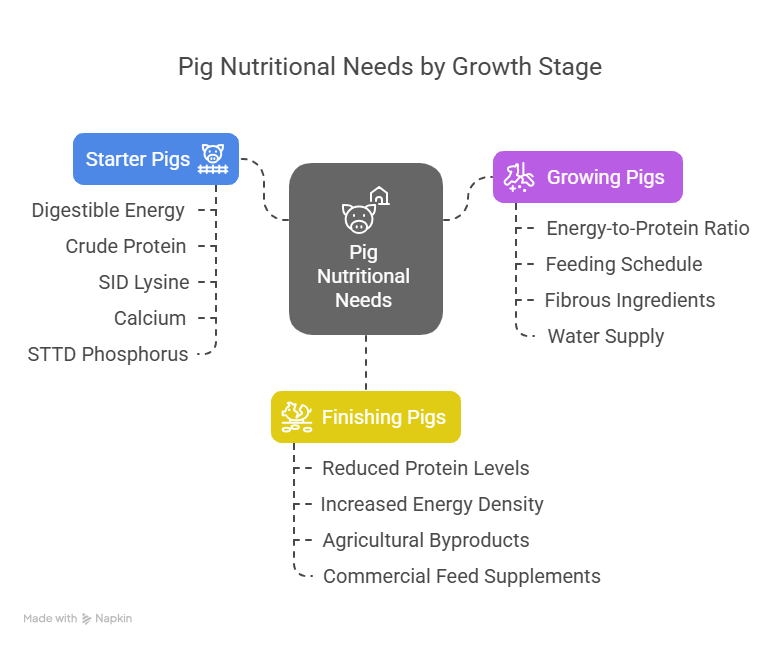
Breeding Stock (Sows and Boars)
Your breeding animals have different nutritional needs compared to market pigs. Pregnant sows need moderate energy to avoid becoming overweight, while lactating sows require significant energy and protein increases to support milk production.
Locally Available Feed Ingredients That Won’t Break the Bank
Energy Sources: The Foundation of Your Pig Diet
The backbone of any cost-effective pig feeding program in Kenya revolves around energy sources you can grow or source locally:
- Maize (ground or whole): The staple energy source used by 88% of smallholder farmers
- Sweet potatoes: Both the tubers and vines can be utilized
- Cassava: Excellent energy source when properly processed to remove toxins
- Millet: Often selected in least-cost feed formulations
These carbohydrate sources provide the fuel your pigs need for maintenance and growth. The beauty is that many can be grown right on your farm as dual-purpose crops—food for your family and feed for your pigs.
Protein Sources: The Growth Builders
Protein remains the most challenging and expensive component in pig diets. Smart smallholders focus on these locally available options:
- Dried fish (omena): Used by 78% of smallholder farmers, provides high-quality protein
- Sweet potato vines: Dual-purpose crop providing both energy and protein
- Cassava foliage: When properly processed to remove anti-nutritional factors
- Slaughter blood: Occasionally available and extremely high in protein
Fruits, Vegetables and Kitchen Waste: Don’t Waste What You Have
About 83% of smallholders feed kitchen leftovers to their pigs—a smart strategy for reducing costs while providing nutrients:
- Avocado: Selected in least-cost formulations
- Mango: Seasonal fruit that pigs enjoy
- Kitchen leftovers: Reduce waste while feeding your animals
- Vegetable trimmings: Good source of vitamins and minerals
Practical Feed Formulation: Mixing Your Own Balanced Diets
Simple Starter Diet for Weaners
Here’s a practical mix you can prepare using local ingredients for young pigs:
| Ingredient | Percentage | Contribution |
|---|---|---|
| Ground maize | 55% | Energy source |
| Dried fish (omena) | 15% | Protein source |
| Sweet potato vines (dried) | 25% | Fiber, vitamins, some protein |
| Bone meal | 3% | Calcium and phosphorus |
| Kitchen salt | 2% | Minerals |
This simple formulation provides approximately 75-80% of the nutrient density of commercial feeds at a fraction of the cost. Remember to cook the maize to increase digestibility.
Growing Pig Diet Using Seasonal Resources
As your pigs grow, you can incorporate more diverse ingredients based on seasonal availability:
| Ingredient | Percentage | Contribution |
|---|---|---|
| Whole maize (cooked) | 40% | Energy source |
| Cassava (processed) | 20% | Energy source |
| Dried fish (omena) | 10% | Protein source |
| Sweet potato vines | 25% | Fiber, vitamins, some protein |
| Mango (when in season) | 3% | Vitamins, palatability |
| Bone meal | 2% | Calcium and phosphorus |
Research has developed twenty-two different diet formulations based on seasonal availability, allowing you to adapt to what’s currently affordable and accessible.
Smart Feeding Strategies That Boost Your Bottom Line
Integrate Crop and Livestock Production
The most successful smallholder pig farmers in Kenya don’t view crops and animals as separate operations. By integrating them:
- Grow dual-purpose crops like sweet potatoes and cassava that provide both human food and animal feed
- Plant napier grass, maize, and sunflower on small land areas that can be harvested as needed
- Use manure from pigs to fertilize crops, creating a sustainable cycle
This approach reduces dependence on purchased inputs and helps maintain more consistent feeding programs throughout the year.
Strategic Use of Commercial Feeds
Sometimes, being completely independent of commercial feeds isn’t practical. The smart approach is strategic integration:
- Use commercial feeds during critical production phases (newly weaned piglets, lactating sows)
- Create a 50/50 mix of commercial and home-prepared feeds to reduce costs while maintaining performance
- Purchase commercial protein supplements to balance home-grown energy sources
Grocery By-Products and Posho Mill Waste: Hidden Treasures
Don’t overlook these readily available and affordable feed sources:
- Grocery by-products that would otherwise be discarded
- Posho mill waste (maize bran) available in rural areas
- Brewery by-products where available
- Fruit processing residues
These materials align with circular economy principles, reducing waste while providing valuable nutrition for your pigs.
Common Feeding Mistakes to Avoid
Inconsistent Feeding Schedule
Pigs thrive on routine. Irregular feeding leads to stress, fighting, and reduced growth. Establish a consistent feeding schedule—ideally twice daily—and stick to it.
Ignoring Water Needs
Most smallholders provide water separately from feeds, which is the right approach. But ensure water is clean, fresh, and available at all times. A pig’s water intake directly impacts feed consumption and growth.
Poor Storage of Feed Materials
Improperly stored feeds develop mold and toxins that can sicken your animals. Ensure all feed ingredients are dried properly and stored in cool, dry conditions away from pests.
Sudden Diet Changes
Abrupt changes in diet composition can cause digestive upsets. Always introduce new feed ingredients gradually over 5-7 days to allow the pig’s digestive system to adapt.
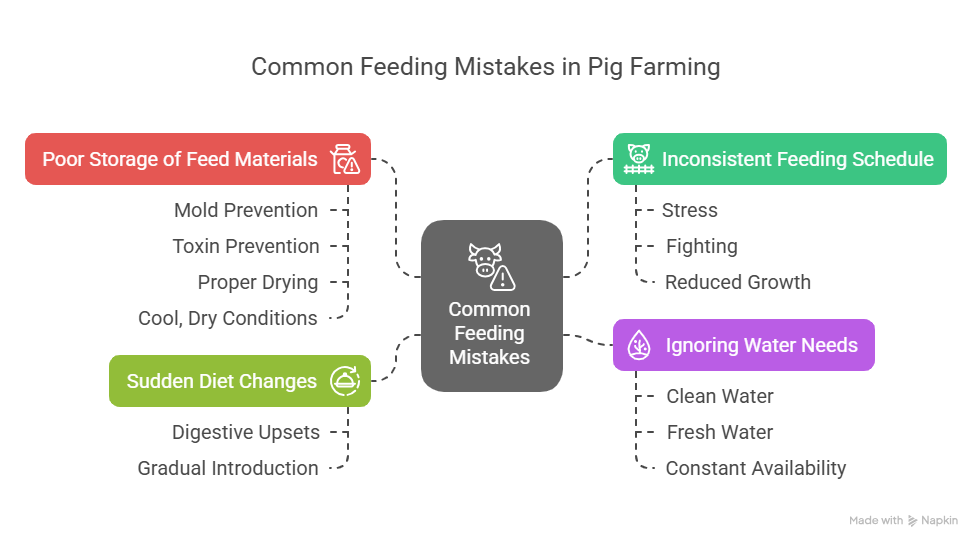
Seasonal Planning for Year-Round Success
One of the biggest challenges in Kenya is seasonal fluctuation in feed availability. Smart farmers plan ahead.
- During harvest season, preserve excess sweet potato vines through drying
- Purchase maize when prices are lowest and store properly
- Process and preserve seasonal fruits like mangoes and avocados when abundant
- Create silage from green materials during rainy seasons for use during dry periods
Measuring Success: Is Your Feeding Program Working?
How do you know if your homemade feed formulations are effective? Watch these key indicators:
- Weight gain: Growing pigs should gain 100-130g daily on well-balanced local feeds
- Feed conversion: Track how much feed is required per kilogram of weight gain
- Physical appearance: Healthy coat, good body condition, alert behavior
- Reproductive performance: Sows maintain condition during lactation and return to heat promptly
Conclusion: Your Path to Profitable Pig Production
Creating effective pig feeding programs in Kenya doesn’t require expensive imported technologies or inputs. By understanding the specific nutritional requirements of local pigs, utilizing seasonally available feedstuffs, and integrating crop and livestock production, you can significantly reduce costs while maintaining acceptable performance.
Remember that the economic viability of your pig operation depends critically on feeding efficiency, access to low or zero-cost feed resources, and market conditions. By implementing the strategies outlined in this guide, you’ll be well-positioned to convert locally available resources into profitable pig production.
What local ingredients are you currently using in your pig feeding program? Have you found creative solutions that work well in your area? Share your experiences in the comments below!
This article is based on research conducted by the International Livestock Research Institute and Food and Agriculture Organization, examining pig feeding practices across Kenya’s diverse production regions.




